Speech Australia and the World

Philip Lowe
[*]
Deputy Governor
Address to Commonwealth Bank Australasian Fixed Income Conference Dinner
Sydney –
Thank you very much for the invitation to join you tonight. It is a pleasure to be here.
This evening I would like to talk about some developments in the international economy and their implications for Australia. Clearly, this is not a new topic. Developments abroad have long had a profound impact on the Australian economy and financial markets, and, no doubt, they will continue to do so. But the unusual nature of recent developments, particularly in the advanced economies, is changing the way in which global outcomes affect Australia. I would like to spend some time this evening talking about these changes.
It is useful to start off with the ‘big picture’ and the key global influences on the Australian economy over recent times. Here, I would point to just two. The first is very much a positive influence – that is, the strong growth over a number of years in many emerging market economies, particularly those in Asia. The second is a negative influence – that is, the fiscal, household balance sheet and banking problems in many of the world's advanced industrialised countries. Together, these two influences are reshaping the contours of the global economic landscape. They are also changing the configuration of interest rates and exchange rates we are seeing in Australia.
The Asian story and its implications for us are well known. The strong growth in the region has led to a marked increase in the prices of resources and agricultural commodities, relative to the price of manufactured goods. This has been to our considerable advantage, given our natural resource base and our stable investment climate. It has meant that at a time when many of the advanced economies have been experiencing what is close to an investment drought, Australia has had the highest level of investment, relative to GDP, in over a century, and a further increase is expected (Graph 1).
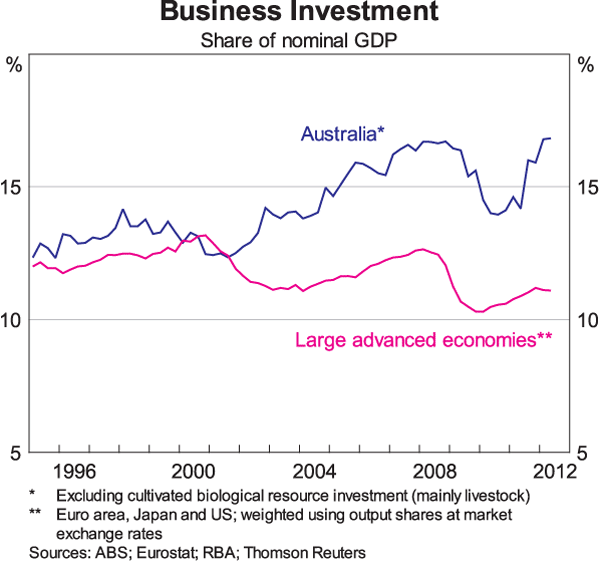
While the growth in Asia is clearly a positive story for Australia, there are inevitably ups and downs in the region and these are having a bigger influence on the Australian economy than was previously the case. Reflecting this, we have recently seen Chinese economic data being discussed much more in Australia than they were just a short time ago. Earlier in the year, growth in China was slowing, but the recent data have had a more positive tone and suggest that growth in China has stabilised, albeit at a lower rate than over the past decade or so.
The story in the advanced economies is also well known, but is much less positive. For too many years, public spending ran ahead of taxes, with the difference financed at low interest rates in the bond market. In some countries, private sector debt also grew too quickly and banks mismanaged their balance sheets. The result has been, and continues to be, a costly period of adjustment. Public finances have to be put on a sounder footing. Households are reducing debt levels. And financial institutions are strengthening their balance sheets. These adjustments take considerable time and it is likely to be some years before they are complete. If this is so, then a protracted period of disappointingly slow growth seems in prospect for a number of these economies.
These two stories are, of course, interlinked. The ongoing momentum in the Asian region has provided some boost to the advanced economies over recent times, and conversely the problems in these advanced economies have contributed to a slowing in Asian growth.
This co-dependence is very much the way of the world. But co-dependence does not mean that it is inevitable that the sluggish growth in the advanced economies must cause the world as a whole to experience sluggish growth. With the right policy settings, it is not inconceivable that strong growth in Asia – driven by domestic demand – could continue despite the problems in the advanced economies. Australia obviously has a very strong interest in this outcome, not least because we have benefited more from the growth in Asia than has any other advanced industrialised economy.
So much for these big-picture influences. I would like to focus on the channels through which the problems in the advanced economies are affecting the rest of the world, including Australia.
The most obvious is the trade channel, with weaker demand from the advanced economies weighing on exports from the rest of the world, including from Asia (Graph 2). This has acted as a drag on growth in the Asian region, although it is important to point out that the experience is nothing like that in late 2008 and 2009. For Australia, the direct trade links with the troubled advanced economies are not as large, although we face important second-round effects through our trade with Asia as well as through softer commodity prices.
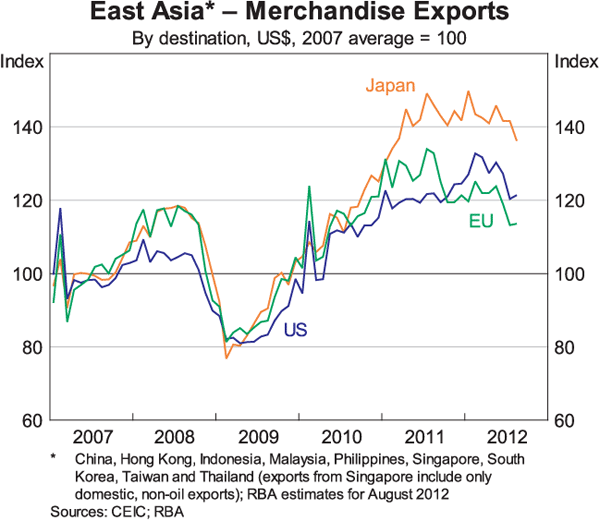
A second channel through which the problems in the advanced economies are having an effect is through adding to uncertainty, for uncertainty leads to decisions being delayed.
The two big uncertainties that have attracted attention over recent times centre on the looming ‘fiscal cliff’ in the United States and the question of how Europe resolves its fiscal and banking problems.
At least in terms of the European question, some progress is being made, albeit frustratingly slowly. A year ago, it was unclear whether the European Central Bank (ECB) would be prepared to buy sovereign debt in large quantities. It was unclear how the funding stresses in the banking system would be resolved. And it was unclear just how much political support there was for more centralised bank supervision as well as the various European financial support mechanisms. Yet, in each of these areas, important decisions have been made. Collectively, these decisions have lessened the probability of a very adverse outcome, though clearly more work needs to be done. Investors rightly want to see more than just high-level decisions from European summits. They want to see agreement on how these decisions are to be implemented. And then they want to see further progress on actual implementation.
This uncertainty stemming from problems in the advanced economies is having an impact here in Australia. It has adversely affected confidence and has led to the deferral of some decisions and more cautious behaviour. But the subdued level of confidence also has domestic roots. Employment growth, the rate of asset price increases and consumption growth are all lower than they were over the decade to the mid 2000s. During this earlier period the outcomes in these areas were very strong as the economy adjusted to low inflation and the increased availability of credit. But this adjustment is now complete, and the return to more normal patterns has come as a disappointing surprise to many who thought that the previous outcomes were the norm. This gradual realisation that the future is likely to be different from the past is an important factor weighing on sentiment in Australia.
A third channel through which the problems in the large industrialised countries are having an effect is through the very accommodative stance of monetary policy in these economies. In the United States, the euro area, Japan and the United Kingdom, official interest rates are either at, or very close, to their lower bound, and the size of the central bank balance sheets has increased markedly.
From one perspective, this setting of monetary policy is hardly surprising. The sluggish growth in many of the advanced economies means that little, or no, progress is being made in reducing high rates of unemployment. At the same time, core inflation is subdued. As a result, monetary policy is accommodative. And with official interest rates effectively at zero, this accommodative setting is being achieved through expansion of central bank balance sheets.
But from another perspective, what we are seeing is highly unusual. Since mid 2008, four of the world's major central banks – the Federal Reserve, the ECB, the Bank of Japan and the Bank of England – have all expanded their balance sheets very significantly, and further increases have been announced in a couple of cases (Graph 3). In total, the assets of these four central banks have already increased by the equivalent of around US$5 trillion, or around 15 per cent of the combined GDP of the relevant economies. We have not seen this type of planned simultaneous very large expansion of central bank balance sheets before. So in that sense, it is very unusual, and its implications are not yet fully understood.
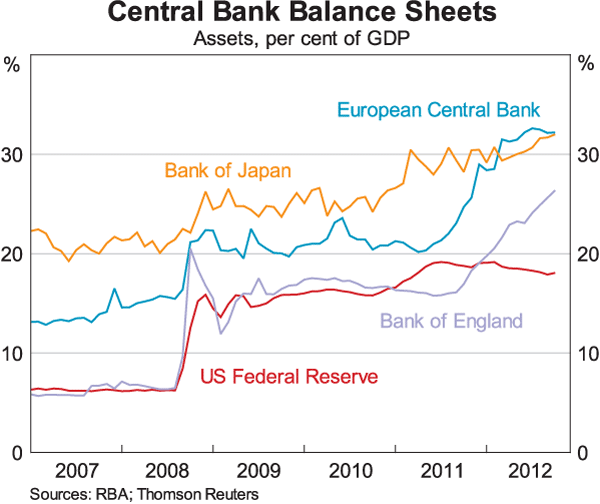
This type of monetary expansion is supposed to work through a number of mechanisms. At the risk of oversimplifying things, I want to focus on just two of these.
The first is that it increases the prices of assets that the central bank is buying, thus lowering the yields on those assets. With the Fed, the Bank of Japan, and the Bank of England all buying their own government's bonds, it is hardly surprising that yields on those bonds are at very low levels (Graph 4). Similarly, in Europe, the prospect of the ECB buying the bonds of troubled sovereigns has seen yields on those bonds decline. Also, in the United States, the Fed's decision to purchase mortgage-backed securities has seen the yields on those securities fall. In general, these lower yields should help provide some boost to spending, just as would lower interest rates from more conventional policy.
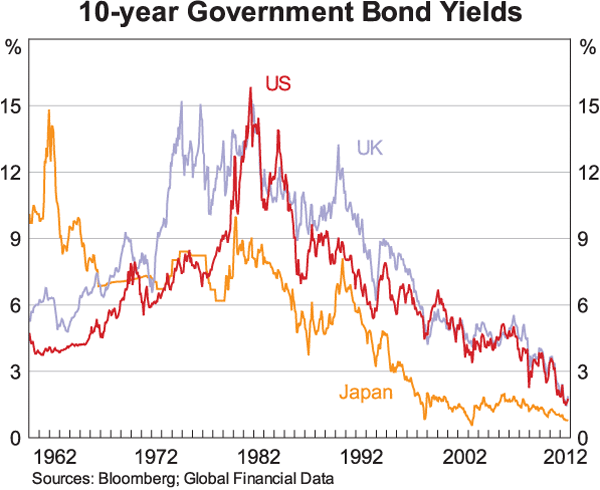
The second mechanism is through asset allocation decisions, as banks and investors adjust their portfolios following the sale of assets to the central bank. These sales lead to an increase in the balances that banks hold at the central bank. In addition, where the ultimate seller of the assets is a non-bank, they also lead to an increase in bank deposits. At some point, the institutions holding these higher balances, which earn zero or very low interest rates, could be expected to conclude that there were other assets somewhere in the world that earned a risk-adjusted return above zero. As institutions seek out these other assets, their prices would be expected to rise. The ever-larger size of these balances increase the incentive for institutions to seek out these other assets.
There is evidence that this transmission channel of quantitative easing is working. Market participants report that, at least in some areas, the appetite for risk is slowly returning, with some investors looking at how to improve their returns. Global stock markets have rallied since the middle of the year. Corporate bond spreads in the United States and Europe have narrowed, and yields are around their lowest levels on record (Graph 5). Corporate bond issuance in the United States has been strong recently and issuance has also picked up in Europe.
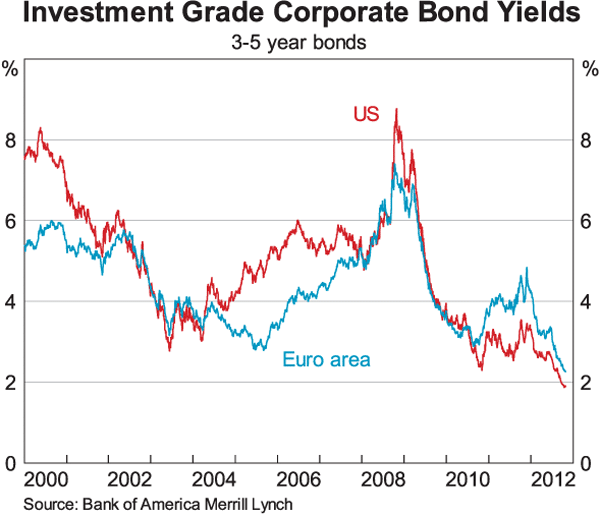
Of course, these developments may not be sustained. Any appetite for increased risk-taking can easily be diminished again by a bad outcome somewhere in the world. But for the time being, in some market segments, conditions are slowly improving. It is not unreasonable to attribute some of this to quantitative easing. Indeed, this is what the textbook tells us should be happening.
There is an important international dimension to all of this as well. When institutions look for alternatives to holding large deposits earning a near zero return, they look not just at domestic assets, but at foreign assets as well. Not surprisingly, with the rest of the world doing better than the troubled advanced economies, many of the assets earning positive risk-adjusted returns are located outside the countries undertaking quantitative easing.
As a result of this, there is an incipient outflow of capital from these countries, and by extension downward pressure on their currencies. Of course, this means that the currencies of some other countries are under upward pressure, which, by itself, weighs on growth in these countries. This is not the end of the story though and there are some potential offsets. The first is that if quantitative easing is successful in boosting growth in the countries in which it is occurring, then the world economy will be stronger. The second is that any rise in asset prices that occurs because of the capital flows might also provide a boost. And the third is that the contractionary effects of an appreciation can be countered with more stimulatory domestic policy-setting – including through lower interest rates – than would otherwise have been the case.
This has, by necessity, been a quick tour through the effects of quantitative easing (perhaps not quick enough for a dinner!). One key point, though, is that quantitative easing and weak growth in the large industrialised economies is likely to lead, for a time at least, to upward pressure on other currencies and lower interest rates around the world. For the countries whose currencies are under upward pressure, this can be uncomfortable. However, it should not come as a surprise that the countries that are doing relatively well see their currencies gain value relative to those that are not doing so well. And it is this movement in exchange rates that is one of the ways in which low interest rates in the large financial centres are transmitted around the globe.
Clearly, the real world is considerably more complex than this. But over recent times a number of the non-crisis countries with floating currencies have indeed found themselves in this general position – that is, they have had low nominal interest rates and a relatively high exchange rate (compared with what was expected). This list here could include, to varying degrees, Canada, South Korea, Switzerland, New Zealand, and some of the Nordic countries. In each of these cases, interest rates are very low by historical standards, and in a number of them the central bank has recently drawn attention to the upward pressure on its currency (Graph 6).
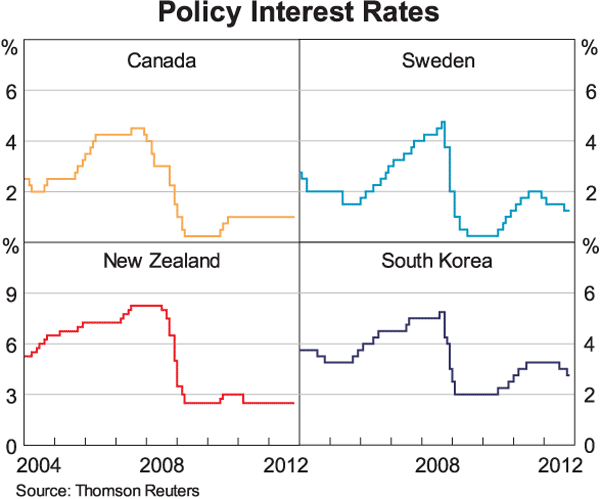
This configuration of low interest rates and a high exchange rate is a consequence of the problems in the advanced industrialised economies. It is inevitably affecting the composition of growth in the countries concerned, although it need not be inconsistent with trend growth. Industries producing traded goods and services tend to be disadvantaged relative to the non-traded parts of the economy. And low interest rates help create an environment where investors are prepared to borrow to buy assets. To some extent this is desirable, and it is one of the channels through which monetary policy works. But it can also increase the probability of imbalances developing in credit and asset markets, with potential implications for financial and macroeconomic stability. Given the experience of the past decade, it is hardly surprising that the central banks in a number of countries have recently indicated that they are watching developments on this front very closely.
So what are the implications for Australia of all of this? It is perhaps useful to make four brief points.
The first is that the primary reason the Australian dollar is high compared with its historical average is the large shift in the relative price of commodities I spoke about at the outset. This shift has been to Australia's advantage, and the high exchange rate has helped us navigate our way through a once-in-a-century investment boom. The economy has recorded solid growth, the unemployment rate remains relatively low, inflation is consistent with the target, public debt is low and the banking system is sound. Few countries can make such claims.
The second is that the types of portfolio flows I talked about earlier do appear to be having an effect here. This effect is perhaps clearest in the government bond market, with yields near historic lows. But it is also evident in the credit markets, with credit spreads paid by banks having fallen recently. It is also likely that these portfolio flows help explain why the exchange rate has changed little since mid year despite a general softening of the global outlook and a decline in key export prices.
The third point is that Australia's interest rates remain above those in other developed economies. The main reason for this is that the rate of return on new investment in Australia is higher than in many other countries, as evidenced by the high level of investment. The very low interest rates in many other economies should not be seen as a good thing or something to aspire to. They reflect those countries' difficult economic circumstances, and particularly the low risk-adjusted returns available on new investment.
The fourth and final point is that while our interest rates are relatively high compared with other countries, they are relatively low compared with historical averages. The international connections that I have talked about tonight help to explain this. These lower-than-average interest rates are providing some support to demand in the economy. There is also some sign that they have led to a slight improvement in the property market, although there has been little change in the appetite for debt. It would appear that, for the moment at least, the lower interest rates, rather than encouraging household borrowing, have allowed many households with mortgages to repay their loans slightly more quickly than was previously the case. These trends will obviously need close monitoring over the period ahead.
So to conclude. These competing influences from Asia and the troubled advanced economies are having a significant effect on the Australian economy, the exchange rate and interest rates. They are creating challenges for both policymakers and investors, and they have added to the sense of uncertainty. What seems clearer though is that Australia's strong trade links with Asia, our solid financial system, our flexible markets and our credible policy framework mean that we are in a better position than many other countries to deal with these challenges. I wish you the best of luck as you navigate your way through this complex world.
Endnote
I would like to thank Tom Rosewall for his valuable assistance in the preparation of this talk. [*]